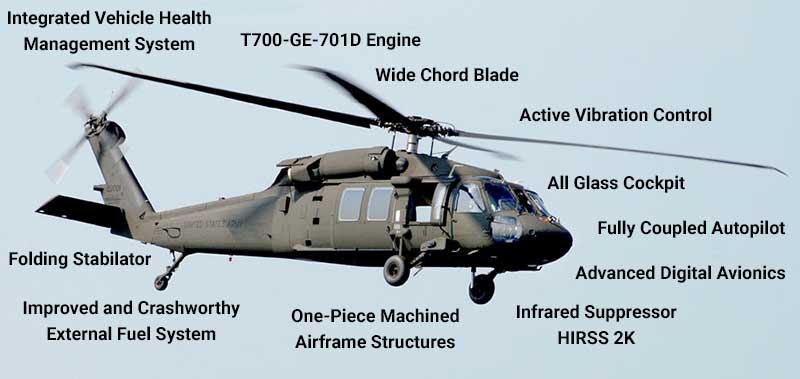Recognizing the Mechanics and Design Behind Uh 60 Helicopters
The UH-60 helicopter, generally understood as the Black Hawk, stands as a peak of modern rotorcraft modern technology, embodying a mix of robust engineering and detailed mechanics. From its inception to its current versions, the development of this aircraft showcases a fusion of advancement and functionality. As we peel back the layers of the UH-60's style, a globe of elaborate systems and precise engineering comes to light. Understanding the technicians and engineering behind this functional airplane reveals a world where precision fulfills power, and where each element plays a vital role in attaining flight.
History of UH-60 Helicopters
The background of UH-60 helicopters traces back to the late 1970s when the United States Military sought a advanced and functional utility helicopter to change its aging fleet. In reaction to this requirement, the Sikorsky Aircraft Corporation established the UH-60 Black Hawk helicopter. Presented in 1979, the UH-60 rapidly became a staple in armed forces procedures as a result of its outstanding abilities.
The UH-60 was designed to master a selection of missions, consisting of troop transport, clinical discharge, digital war, and special operations. Its capacity to adjust to various roles made it a beneficial possession to the united state Army and various other army forces all over the world
Throughout the years, the UH-60 platform has actually undergone several upgrades and variations to boost its efficiency and equal advancing objective requirements. These helicopters have seen extensive solution in problems such as the Gulf War, Afghanistan, and Iraq, showcasing their dependability and adaptability in varied functional settings. The UH-60's abundant history is a testimony to its enduring legacy as a top energy helicopter.

Engine and Power Solutions
Using innovative propulsion technology, UH-60 helicopters are geared up with sophisticated engine and power systems to ensure optimal efficiency and reliability in a series of functional circumstances. The UH-60, typically recognized as the Black Hawk, is powered by 2 General Electric T700-GE-701D engines, each with the ability of providing up to 1,940 shaft horsepower. These turboshaft engines offer the needed thrust for the helicopter to perform its objectives effectively, including troop transport, clinical emptying, and battle support.

Blades System and The Rules Of Aerodynamics
Just how do the rotor system and aerodynamics of UH-60 helicopters add to their operational effectiveness and flight capabilities? The blades system of the UH-60 helicopter plays a critical duty in providing lift and propulsion. The UH-60 includes a four-bladed, completely verbalized rotor system that enables high maneuverability and stability throughout flight. This layout makes it possible for the helicopter to execute a broad array of missions, from transport and medical discharge to deal with procedures.
The rules of aerodynamics also play a vital function in the performance of UH-60 helicopters. The structured fuselage and blades blade design reduce drag, permitting the helicopter to achieve higher speeds investigate this site and far better gas efficiency. The aerodynamic design of the UH-60 additionally contributes to its capability to operate in varied environmental conditions, consisting of high altitudes and warm temperature levels.
Avionics and Flight Control Equipment

In its complex coordination with the blades system and the rules of aerodynamics of UH-60 helicopters, the avionics and flight control systems create a critical network of modern technologies shaping the aircraft's operational abilities. In the UH-60, these systems consist of electronic displays, interaction radios, General practitioner navigation, weather condition radar, and autopilot systems.
The flight control systems of the UH-60 are in charge of equating the pilot's inputs right into the proper modifications to the blades system, making certain steady trip and maneuverability. These systems include hydraulic actuators, servos, and computer systems that interact to manage the main and tail rotors, as well as various other trip control surface areas. By precisely handling the helicopter's flight dynamics, these systems make it possible for pilots to execute a broad variety of goals, from transport and search-and-rescue to deal with operations, with accuracy and confidence.
Role and Applications in Aeronautics
Avionics systems in UH-60 helicopters include an array of electronic systems that aid in navigating, communication, tracking, and controlling numerous airplane features. These systems consist of electronic displays, autopilot systems, communication radios, General practitioner navigating devices, and weather condition radar. Additionally, these systems incorporate security functions such as auto-pilot settings, terrain awareness advising systems, and stability augmentation systems to boost the total safety and functional capacities of the UH-60 helicopters in various objectives, consisting of army transport, clinical emptying, search and rescue, and aerial firefighting.
Final Thought
In final thought, the UH-60 helicopter is a functional airplane with an abundant history and progressed design. Its engine and power systems, blades system, aerodynamics, avionics, and flight control systems check that all function together to make it a reliable and trustworthy device.
In its complex control with official website the blades system and the rules of aerodynamics of UH-60 helicopters, the avionics and flight control systems develop an essential network of modern technologies forming the airplane's functional capabilities.The trip control systems of the UH-60 are accountable for equating the pilot's inputs right into the appropriate changes to the blades system, guaranteeing secure flight and maneuverability. Avionics systems in UH-60 helicopters incorporate a variety of electronic systems that help in navigation, interaction, tracking, and controlling numerous airplane functions. In addition, these systems integrate security features such as auto-pilot modes, terrain recognition advising systems, and stability enhancement systems to boost the general safety and security and functional abilities of the UH-60 helicopters in various objectives, including army transportation, medical discharge, search and rescue, and airborne firefighting.
Its engine and power systems, rotor system, aerodynamics, avionics, and flight control systems all function together to make it a reliable and dependable machine.